CyberPowerPC's Gamer Xtreme 4000: Now with Sandy Bridge
by Dustin Sklavos on January 4, 2011 12:00 AM EST- Posted in
- Systems
- Intel
- Sandy Bridge
- CyberPowerPC
- NVIDIA
Gaming Performance
The NVIDIA GeForce GTX 570 in the CyberPower 4000 is no slouch, but it's facing tough competition from some of the other desktops we've tested. Keep in mind that the 4000 is also the least expensive desktop (or at least quoted least expensive) in our lineup, though. Starting with the "High" preset we'll see if the i7 can pick up some of the slack here, but we expect the 4000 to generally fall in about the middle of the pack.
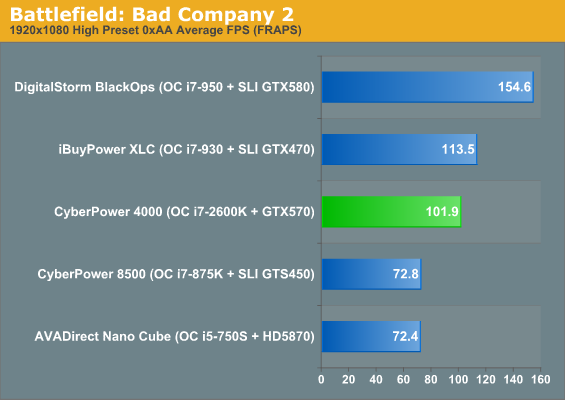

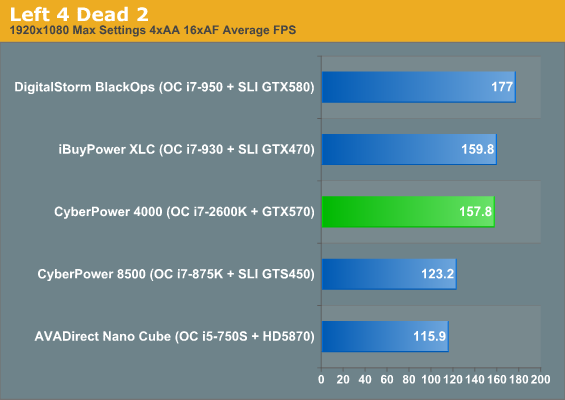
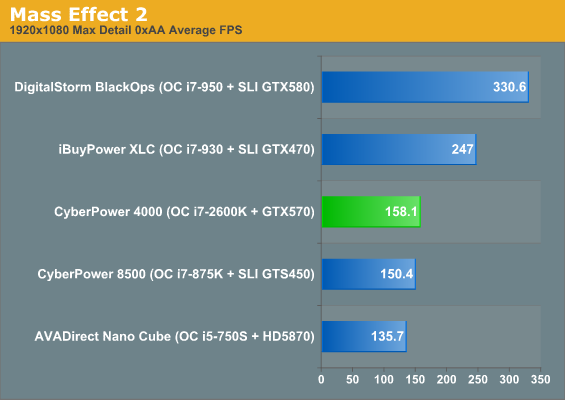

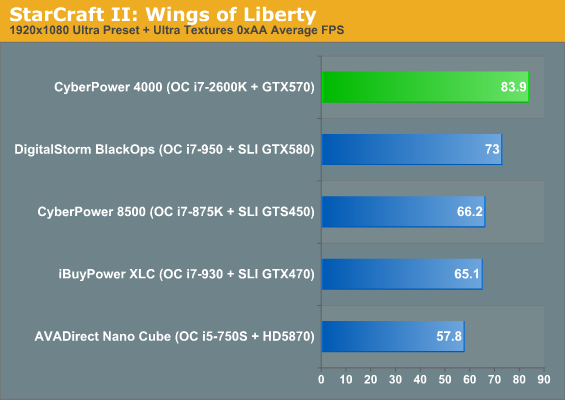
Sure enough, the GTX 570 falls in line squarely where we expected, with the only win going to the notoriously CPU-limited, poorly-threaded StarCraft II. What possessed Blizzard to release a game that only scales up to two cores in 2010, we'll never know. Things should remain consistent when we bounce up to our "Ultra" preset, and hopefully that'll shift enough of the load to the graphics subsystem in StarCraft II to bring it in line.
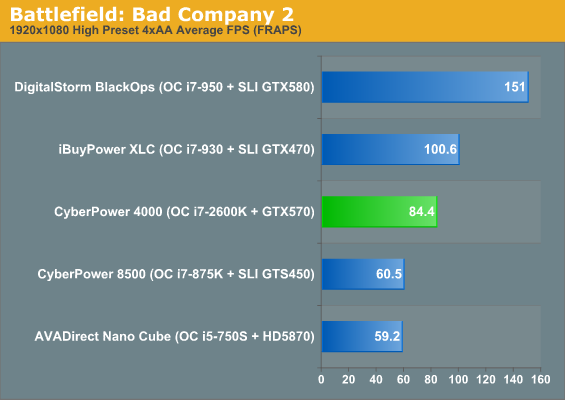
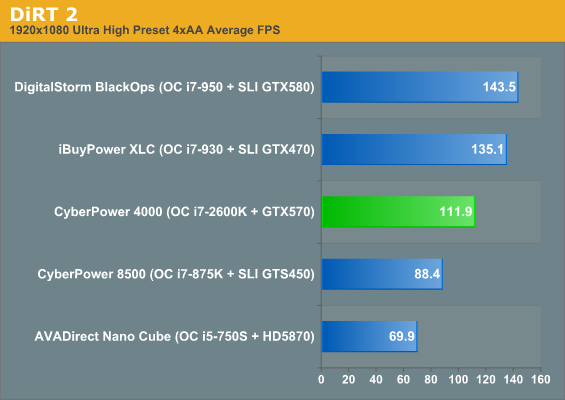
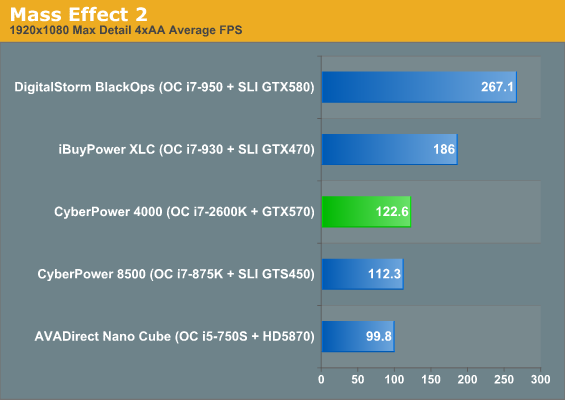

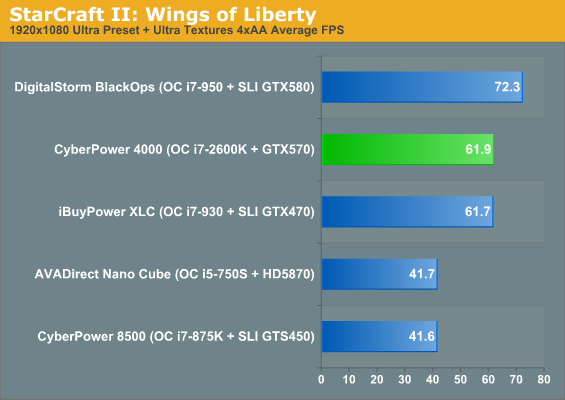
As expected, everything places about where it's supposed to. The comparatively tame 3.5GHz overclock on the iBuyPower XLC is enough to strangle the SLI'd GTX 470s in that build in StarCraft II, but beyond that everything falls into place. Any of these systems are still incredibly fast, though. What we'd like to see is what would happen if a massively overclocked i7-2600K was paired with SLI'd GTX 580s; I had a sneaking suspicion that even a 3.8 GHz i7-950 was still going to be a little bit limiting on a graphics system that powerful, so it would be interesting to see if the 2600K could alleviate that bottleneck.










42 Comments
View All Comments
Anosh - Tuesday, January 4, 2011 - link
Am I the only one not getting very much out of this review due to the mix of hardware; single gpu vs sli both with different cpu generations and overclock? I can't get a proper perspective to be able to decide if this system is performing as it should or better.vol7ron - Tuesday, January 4, 2011 - link
Yes and no. It's not the easiest to compare, but AT is given what they're given, you sort of have to fill in the rest.Something's better than nothing. I'm still unimpressed to see the BCLK wasn't touched; but I don't know much about OC. If you raise the voltage, does it become a static voltage? Also, is the speedstep/turbo (whatever it's called) still employed, or do you only have one steady OC when up'ing the voltage.
44x multiplier is pseudo decent, I'd expect more from liquid cooled. I'd also expect the BCLK to get up to 104-107.
beepboy - Tuesday, January 4, 2011 - link
Sandy Bridge has a built in clock generator, so raising the BCLK will result in system instability and the gains from it is abysmal. I suggest you read Anand's earlier post on Sandy Bridge.On nicer boards (even on current P55), you can raise CPU voltage as 'offset'. This isn't static, and the board will manage the voltage as required by the CPU and applying the offset. So at maximum TDP the board will add whatever offset you applied. This is nice because during idle you can still have sub 1 V draw.
Moore's law will still apply and I think there's a soft wall (binning) past the 44x multiplier. These systems go through extensive 24 hour burn-in test with multiple benches for system stability and I bet if they could have been pushed further they would have.
7Enigma - Tuesday, January 4, 2011 - link
Hi Dustin,I disagree with your conclusion that the OC on the system can be let off the hook. The fact that SandyBridge is so easy to OC (due to the limited amount of factors you can actually change) means it takes much LESS effort than previous CPU's. Flipping a multiplier setting in the BIOS while making no other changes is borderline brainless. I'm sure ALL boutique builds using the new chip will have similar OC's so giving them a pass because they kept idle voltages low is like giving them credit for Intel's work.....
The caveat to this post is (if they don't pull the switch-aroo again) is that the build price is low enough when factoring in the components that the OC can almost be considered "free".
vol7ron - Tuesday, January 4, 2011 - link
I agree. I'm just now reading your comment and I've already left two other comments about the OC.Sometimes vendors charge extra for an OC, since it does require more manual intervention. Perhaps that's what happened here; they got a standard OC (just the multiplier), but you could pay more money and get the the timings/vcore/bclk adjusted as well.
To me this isn't considered an "OC" by CyberPower, it's merely changing a config setting.
JarredWalton - Tuesday, January 4, 2011 - link
Keep in mind that this is the first encounter Dustin has had with SNB, and his review was written separately (and before) Anand's write-up. I've added an editor's note on the overclock and modified things a bit, but honestly we have to wait and see what other vendors are willing to offer before we can truly say how this OC stands up. It's certainly more compelling than the stuff Dustin encountered with the previous 1366/1156 platforms, but that may simply be the Sandy Bridge influence. I have a feeling most reasonable overclocks on 2600K will fall into the 4.6GHz Turbo range, and I'm not really sure praising the final 4.5% overclock (relative to this 4.4GHz) is really that useful.7Enigma - Tuesday, January 4, 2011 - link
Hi Jarred,Thanks for the reply. I guess my problem is the artificial limitation placed on a REALLY GOOD (thermally) chip by having everything but the voltages and multiplier essentially locked. The number of variables removed (and the smaller reliance on quality ram/mobo and tweaks as per Anand's review of the SNB platform) makes the job EASIER for the boutique builders to get a great OC that it makes me MORE critical not less.
You mentioned the 1366/1156 platforms, but all of those required (or should have) a lot more time invested in setting voltages/timings/etc. Yes the one review that had the cpu constantly run at a high clock-speed was unforgivable, but the other systems where "lazy" was thrown around probably took significantly more effort than the xtreme4000 which (without me seeing the bios settings firsthand) was likely a SINGLE number change for the multiplier (ok maybe 4 changes.....all with the same number) since it was mentioned in the review that everything else was left on auto.
When you get such a mature process as SNB where you can get hefty OC's using the rinky-dink stock Intel cooler, I think we need to hold these builders to a higher standard.
Thanks again for taking the time to read and respond to comments.
vol7ron - Tuesday, January 4, 2011 - link
I thought Anand got 4.4-to-4.5 GHz on stock air cooling. Something seems wrong when they only got 4.4GHz with liquid cooling.7Enigma - Tuesday, January 4, 2011 - link
Nothing is wrong, it's just a completely sloppy OC. These new chips allow a single change to be made (the multiplier) and you can OC quite a bit due to the great thermals. So rather then chew out Cyberpower for a (literally) 2-second OC job, they get praised for not changing the idle clocks.Again it's tough to be harsh due to the price (if they actually are going to honor the price from the review), but let's call a spade a spade, it's a basic OC in every sense of the word.
Stuka87 - Tuesday, January 4, 2011 - link
So correct me if I am wrong, I was tired when I read the Sandy Bridge Article, but the over clock here is only for when the chip is in Turbo mode correct?IE: If all 4 cores are in use, its running at 3.4?